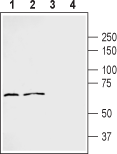Overview
- Peptide (C)GAPPRYATLEHPFH, corresponding to amino acid residues 192-205 of rat Frizzled-2 (Accession Q08464). Extracellular, N-terminus.

 Western blot analysis of rat heart lysate:1. Anti-Frizzled-2 (FZD2) (extracellular) Antibody (#AFR-022), (1:200).
Western blot analysis of rat heart lysate:1. Anti-Frizzled-2 (FZD2) (extracellular) Antibody (#AFR-022), (1:200).
2. Anti-Frizzled-2 (FZD2) (extracellular) Antibody, preincubated with Frizzled-2/FZD2 (extracellular) Blocking Peptide (#BLP-FR022). Western blot analysis of human MDA-231 breast carcinoma cell line lysate (lanes 1 and 3) and human THP-1 acute monocytic leukemia cell line lysate (lanes 2 and 4):1,2. Anti-Frizzled-2 (FZD2) (extracellular) Antibody (#AFR-022), (1:200).
Western blot analysis of human MDA-231 breast carcinoma cell line lysate (lanes 1 and 3) and human THP-1 acute monocytic leukemia cell line lysate (lanes 2 and 4):1,2. Anti-Frizzled-2 (FZD2) (extracellular) Antibody (#AFR-022), (1:200).
3,4. Anti-Frizzled-2 (FZD2) (extracellular) Antibody, preincubated with Frizzled-2/FZD2 (extracellular) Blocking Peptide (#BLP-FR022).
- Schulte, G. (2010) Pharmacol. Rev. 62, 632.
- Foord, S.M. et al. (2005) Pharmacol. Rev. 57, 279.
- Dijksterhuis, J.P. et al. (2014) Br. J. Pharmacol. 171, 1195.
Frizzled receptors (FZD) belong to the superfamily of G-protein coupled receptors (GPCR). They are classified to the frizzled subfamily for which 11 members have been identified to date; FZD1-10 and Smoothened1. They were first identified in Drosophila melanogaster.
Like all GPCRs, Frizzled receptors have seven transmembrane domains, an extracellular N-terminus and an intracellular C-terminal tail. However, these receptors lack many features of the conventional class A, B or C GPCRs2.
Activation of these receptors by WNT, leads to numerous complex signaling pathways which are generally termed β-catenin-dependent and β-catenin-independent. It is noteworthy to mention that the β-catenin-dependent pathway involves the interaction of FZD with LRP6 or LRP5 co-receptors3.
Frizzled receptors are ubiquitously expressed and play a crucial role in embryo development. They are also significantly involved in proliferation and differentiation. Indeed, dysregulation of FZD leads to various forms of cancer1. Scientific evidence also shows their involvement in axonal remodeling and neurotransmitter release1.
They have been associated to Alzheimer’s and Parkinson’s diseases, depression, anxiety, hypoxia and ischemia. It is thus not surprising that they have become pharmacological targets in a number of diseases and disorders.
Application key:
Species reactivity key:
Alomone Labs is pleased to offer a highly specific antibody directed against an epitope of rat Frizzled-2. Anti-Frizzled-2 (FZD2) (extracellular) Antibody (#AFR-022) can be used in western blot analysis. The antibody recognizes an extracellular epitope and is thus ideal for detecting the receptor in living cells. It has been designed to recognize FZD2 from rat, mouse and human samples.

